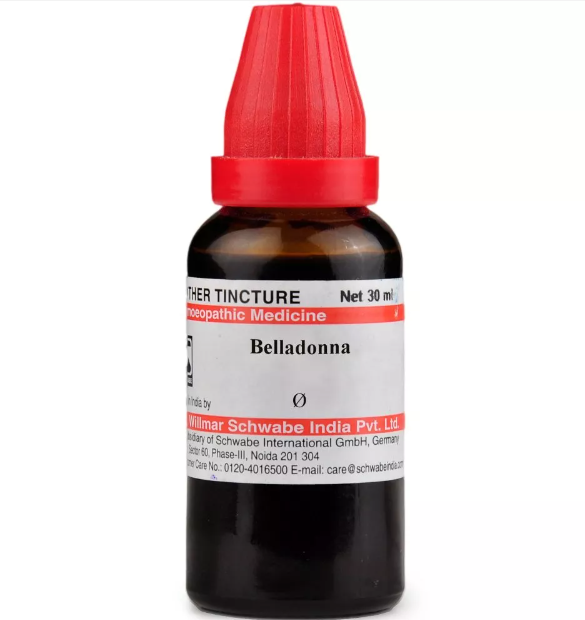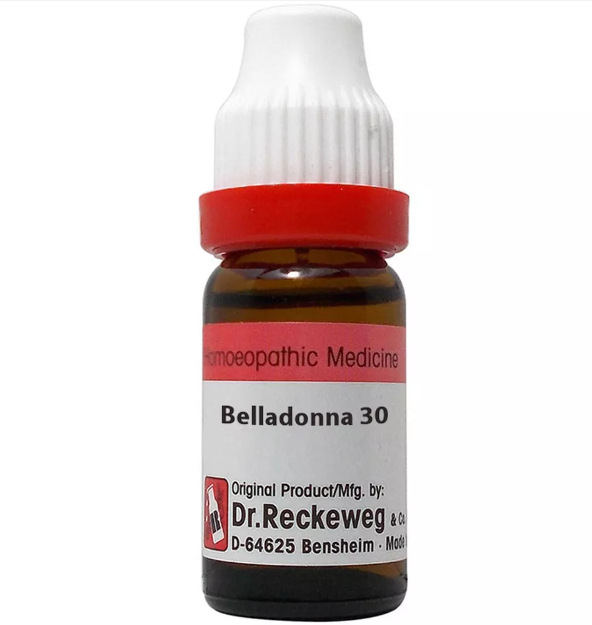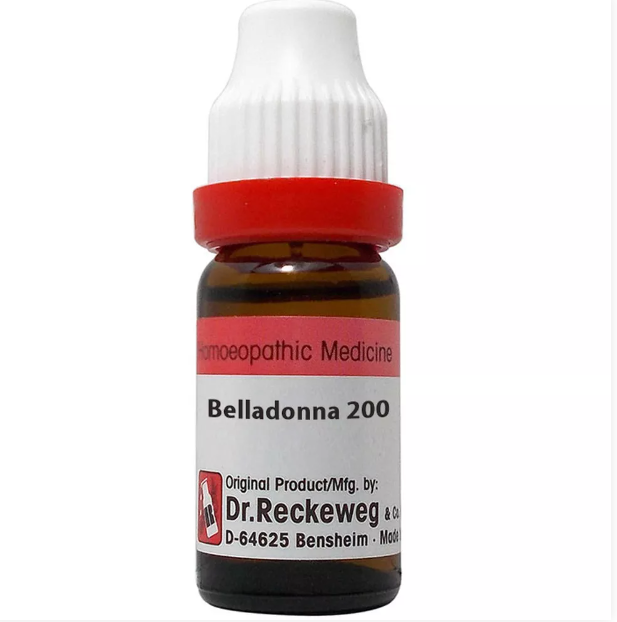BELLADONNA Q, 6C, 12C, 30C, 200C, 1M, 10M USES AND SYMPTOMS
 Belladonna (Deadly Nightshade)
Belladonna (Deadly Nightshade)
Bell.
Belladonna influences the entire nervous system, inducing active congestion, intense excitement, distorted senses, spasms, convulsions, and agony. It notably affects the vascular system, skin, and glands. Belladonna always manifests with hot, red skin, flushed face, glaring eyes, pulsating carotids, heightened mental state, heightened sensitivity of all senses, delirium, restless sleep, convulsive motions, dry mouth and throat with an aversion to water, and sudden neuralgic pains (Oxyt.). Heat, redness, pulsation, and burning sensations prevail. An exceptional remedy for children. Epileptic seizures followed by nausea and vomiting. Scarlet fever prevention and treatment, with the thirtieth potency utilized. Effective for exophthalmic goitre. Matches symptoms of “air sickness” in aviators. Suitable as a preventive measure. Absence of thirst, anxiety, or fear. Belladonna represents intense attack and sudden onset. Bell. is indicated in severe thyroid toxemia. 1x potency recommended (Beebe).
Mind: Patient inhabits an inner realm, absorbed in apparitions and visions, disconnected from reality. Although oblivious to tangible objects, the mind is inundated with vivid hallucinations and fantastical illusions. Hallucinations include monstrous and grotesque imagery. Delirium featuring terrifying visions, agitation, aggressive behavior, and a desire to flee. Loss of consciousness. Unwillingness to communicate. Contrary behavior, accompanied by tears. Heightened sensitivity in all senses. Variable temperament.
Head: Vertigo, with tendency to fall leftward or backward. Excessive sensitivity to touch. Intense throbbing and heat. Palpitations resonate in the head, accompanied by difficult breathing. Pain, particularly in the forehead, occiput, and temples. Headaches triggered by suppressed nasal discharge. Sudden vocal outbursts. Pain worsened by light, noise, movement, lying down, and afternoon; relieved by pressure and semi-upright position. Head presses into the pillow, with head turning and tossing (suggestive of meningitis, hydrocephalus). Persistent moaning. Dry, brittle hair with hair loss. Headaches aggravated on the right side and when lying down; adverse effects from haircuts, colds, etc.
Eyes: Deep eye throbbing when lying down. Dilated pupils (Agn.). Eyes feel swollen and protruding, with intense gaze, reddened conjunctiva, dryness, burning sensation, and sensitivity to light; eye pain (conjunctivitis). Protrusion of eyeballs. Visual distortions, such as fiery appearance. Double vision, squinting, and eyelid spasms. Sensation of partially closed eyes. Swollen eyelids. Congested fundus.
Ears: Sharp pain in middle and outer ear. Ringing in ears. Bulging and inflamed tympanic membrane. Swollen parotid gland (mumps, parotiditis). Sensitive to loud noises. Acute otitis media. Pain inducing delirium. Child cries out in sleep; deep ear pain synchronized with heartbeat. Auricular hematoma. Acute and subacute eustachian tube conditions. Autophony, perceiving one’s own voice in the ear.
Nose: Perception of imaginary odors. Tingling sensation in nasal tip. Red and swollen nose. Nosebleeds, with flushed face. Runny nose with blood-mixed mucus.
Face: Red, bluish-red, hot, swollen, shiny; facial muscle spasms (epilepsy). Swollen upper lip. Facial neuralgia accompanied by muscle twitching and flushed complexion.
Mouth: Dry mouth. Throbbing toothache. Gum boil. Red-edged tongue. Strawberry tongue. Teeth grinding. Swollen and painful tongue (glossitis). Speech impediment.
Throat: Dry, glazed appearance; angry congestion (Gins.); more pronounced on the right side. Enlarged tonsils (tonsillitis); sensation of throat constriction; swallowing difficulty; worsened by liquids. Feeling of a lump. Dry esophagus; sensation of constriction. Throat spasms. Persistent urge to swallow. Scratchy sensation. Overly sensitive swallowing muscles. Mucous membrane hypertrophy.
Stomach: Decreased appetite. Aversion to meat and milk. Spasmodic epigastric pain. Constriction; pain extending to spine. Nausea and vomiting. Strong thirst for cold water. Stomach spasms. Empty retching. Aversion to liquids. Spasmodic hiccups. Aversion to drinking. Uncontrollable vomiting.
Abdomen: Swollen, hot, distended. Transverse colon protrudes like a pad. Tender, swollen abdomen. Sensation of being grasped; worsened by pressure and movement. Cutting pain across abdomen; stitching pains on left side aggravated by coughing, sneezing, or touch. Extreme sensitivity to touch, bedclothes, etc. (Lach.).
Stool: Thin, green, dysenteric; lumpy like chalk. Shuddering during bowel movements. Stinging rectal pain; spasmodic constriction. Hemorrhoids more sensitive with backache. Rectal prolapse (Ign., Podo.).
Urinary: Retention. Acute urinary tract infections. Sensation of bladder movement, resembling a worm. Scanty, tenesmus-induced urine; dark and cloudy, with phosphate deposits. Bladder region sensitivity (cystitis). Continuous dribbling incontinence. Frequent and profuse urination. Unexplained hematuria. Prostate enlargement.
Male: Hard, retracted, inflamed testicles (orchitis). Nocturnal genital sweating. Prostatic fluid flow. Reduced desire.
Female: Sensation of pelvic organs descending (prolapse). Vaginal dryness and heat. Dragging pain in lower back. Sacral pain. Increased, bright red, early, and profuse menstruation (menorrhagia). Hot, offensive-smelling menstrual and postpartum discharge. Sudden labor pains. Mastitis, with throbbing pain, redness, and radial streaks from nipple. Heavy, hard, and red breasts. Breast tumors with worsened pain when lying down. Offensive-smelling, hot hemorrhages. Reduced postpartum discharge.
Respiratory: Dryness in nose, throat, larynx, and trachea. Tickling, dry cough; worsened at night (bronchitis). Sore throat. Labored, rapid, irregular breathing. Cheyne-Stokes respiration (Cocain., Op.). Hoarseness; loss of voice. Pain-free hoarseness. Cough with hip pain. Barking cough, whooping cough with pre-attack stomach pain and cough-induced hemoptysis. Chest pains during coughing (pneumonia). Painful larynx; sensation of foreign object, accompanied by cough (laryngitis). High-pitched voice. Groaning with every breath.
Heart: Forceful palpitations, felt throughout the body, accompanied by difficult breathing. Palpitations triggered by minimal exertion. Pulsating sensations all over. Dichrotism. Perception of enlarged heart. Rapid but weak pulse.
Back: Stiff neck. Neck gland swelling. Nape pain, as if breaking (cervical spondylosis). Maximum pressure in dorsal region. Lumbago, accompanied by hip and thigh pain.
Extremities: Shooting pains along limbs. Swollen, red, shiny joints with red streaks. Unsteady gait. Variable rheumatic pains. Phlegmasia alba dolens. Limb jerking. Muscle spasms. Involuntary limping. Cold extremities.
Sleep: Restless sleep, accompanied by vocalizations and teeth grinding. Awakened by blood vessel pulsations. Shouting during sleep. Insomnia with drowsiness. Startling upon closing eyes or during sleep. Sleeping with hands under head (Ars., Plat.).
Fever: High fever state, with limited toxemia. Burning, pungent heat. Cold feet. Dilated superficial blood vessels. Dry head perspiration. Absence of thirst during fever.
Skin: Dry, hot, swollen, sensitive, burning, scarlet, and smooth (cellulitis). Rapidly spreading scarlet fever-like rash. Erythema; facial pustules.
Swollen, tender, red glands. Boils. Rosacea. Suppurative wounds. Alternating skin redness and paleness. Skin induration after inflammation. Erysipelas. Modifiers: Aggravated by touch, movement, noise, draft, afternoon, and lying down. Alleviated by semi-upright position.
Relationships: Compare with Sanguisorba officinalis 2x-6x (for profuse, prolonged menses, especially in neurotic patients with congestive head and limb symptoms. Passive hemorrhages during menopause. Chronic metritis. Lung hemorrhage. Varicose veins and ulcers). Mandragora officinarum (Mandrake), an ancient narcotic (restless excitability and physical weakness, desire for sleep. Similar antiperiodic effects as Chin. and Aran. Beneficial for epilepsy and hydrophobia, and Cetonia aurata (A. E. Lavine). Hyos. (less fever, more agitation); Stram. (increased sensorial excitement, frenzy); Hoitzia coccinea, a Mexican drug akin to Bell. (effective in fever, scarlet fever-like rash, measles, urticaria, etc. High fever with red rashes. Dry mouth and throat, flushed face, bloodshot eyes, delirium). Calc. often required after Bell., Atropinum. Belladonna’s alkaloid covers the neurotic sphere more (severe throat dryness, nearly impossible swallowing. Chronic stomach ailments, with severe pain and food vomiting. Peritonitis. Various sight illusions. Enlarged perception of objects (Platina opposite). Hypochlorhydria; heartburn. Visual disturbances, diplopia, elongated objects. Eustachian tube and ear congestion. Pancreatic affinity. Gastric pain spasms; ovarian neuralgia).
Non-homeopathic Uses: Atropinum and its salts used in ophthalmology to dilate pupils and paralyze accommodation.
Internally or subcutaneously used as an antagonist to Opium and Morphinum. Physostigma and Prussic acid. Narcotic and mushroom poisonings. Renal colic treated with hypodermic doses of 1-200 of a grain.
Atropin, injected subcutaneously from a milligram upwards, aids in life-threatening intestinal obstruction.
Hypodermic doses of 1-80 gr. alleviate night sweats in tuberculosis. Atropia 1-20 gr. counters 1 gr. Morphine.
Also employed as local anesthetic, antispasmodic, and to dry secretions, including milk.
Dosage: Atropinum sulphuricum, 1-120 to 1-60 grain.
Belladonna antidotes: Camph., Coff, Op., Acon.
Complementary: Calc., especially in semi-chronic and constitutional ailments.
Incompatible: Acet-ac.
Dosage: First to thirtieth potency and beyond. Frequent repetition recommended in acute conditions.
SYMPTOMS OF BELLADONNA
Nervous System Symptoms:
- Active congestion
- Intense excitement
- Distorted senses
- Spasms
- Convulsions
- Agony
- Delirium
- Restless sleep
- Convulsive motions
Vascular System, Skin, and Gland Symptoms:
- Hot, red skin
- Flushed face
- Glaring eyes
- Pulsating carotids
- Heightened mental state
- Heightened sensitivity of all senses
- Dry mouth and throat with aversion to water
- Sudden neuralgic pains
Mind Symptoms:
- Inhabiting an inner realm, disconnected from reality
- Vivid hallucinations and fantastical illusions
- Hallucinations of monstrous and grotesque imagery
- Delirium featuring terrifying visions and aggressive behavior
- Loss of consciousness
- Unwillingness to communicate
- Variable temperament
Head Symptoms:
- Vertigo
- Excessive sensitivity to touch
- Intense throbbing and heat
- Palpitations in the head
- Pain in forehead, occiput, and temples
- Headaches triggered by suppressed nasal discharge
Eye Symptoms:
- Deep eye throbbing
- Dilated pupils
- Protruding and swollen eyes
- Visual distortions and double vision
- Sensation of partially closed eyes
- Conjunctival redness and dryness
Ear Symptoms:
- Sharp pain in middle and outer ear
- Ringing in ears
- Swollen parotid gland
- Acute otitis media
Nose Symptoms:
- Perception of imaginary odors
- Red and swollen nose
- Runny nose with blood-mixed mucus
Face Symptoms:
- Red, bluish-red, hot, swollen, shiny face
- Facial muscle spasms
- Swollen upper lip
Mouth and Throat Symptoms:
- Dry mouth
- Throbbing toothache
- Gum boil
- Red-edged tongue
- Tongue swelling and pain
- Difficulty swallowing
- Sensation of throat constriction
Stomach and Abdominal Symptoms:
- Decreased appetite
- Spasmodic epigastric pain
- Nausea and vomiting
- Abdominal distension
- Sensitivity to touch in the abdomen
Urinary and Genital Symptoms:
- Urinary retention
- Acute urinary tract infections
- Sensation of bladder movement
- Swollen and inflamed testicles
- Nocturnal genital sweating
Respiratory Symptoms:
- Dryness in nose, throat, larynx, and trachea
- Tickling, dry cough
- Labored and irregular breathing
- Hoarseness and loss of voice
Heart Symptoms:
- Forceful palpitations
- Perception of enlarged heart
- Rapid but weak pulse
Back and Extremities Symptoms:
- Stiff neck
- Swollen glands in neck
- Lumbago with hip and thigh pain
- Shooting pains along limbs
Sleep and Fever Symptoms:
- Restless sleep with vocalizations and teeth grinding
- Insomnia with drowsiness
- High fever state with burning heat
- Dry head perspiration
Skin Symptoms:
- Dry, hot, swollen, sensitive, burning skin
- Rapidly spreading scarlet fever-like rash
- Erythema and facial pustules

selection of the potency
Individualization:
- Homeopathy is based on the principle of treating the individual, not just the disease. The unique symptoms and characteristics of the person are crucial in determining the most suitable potency.
Intensity of Symptoms:
- The intensity of the symptoms guides the choice of potency. If the symptoms are intense and acute, a lower potency (e.g., 6C, 30C) might be considered. For chronic conditions with less intensity, higher potencies (e.g., 200C, 1M) may be appropriate.
Sensitivity of the Patient:
- Some individuals are more sensitive to homeopathic remedies, while others may require higher potencies. The practitioner considers the patient’s sensitivity when selecting the potency.
Acute vs. Chronic Conditions:
- Lower potencies are often used for acute conditions, while higher potencies may be considered for chronic or long-standing issues.
Previous Response to Potencies:
- The patient’s response to previous homeopathic treatments helps guide the choice of potency. If a particular potency has been effective in the past, it may be repeated or adjusted as needed.
Vital Force and Susceptibility:
- Homeopathy views illness as a disturbance in the vital force. The practitioner assesses the patient’s overall vitality and susceptibility to determine the appropriate potency.
Aggravation or Amelioration:
- The direction of the symptom response (aggravation or amelioration) after taking a remedy can influence the choice of potency.
Miasmatic Considerations:
- In classical homeopathy, the concept of miasms (inherited disease tendencies) is considered. The practitioner take this into account when selecting the potency.
Practitioner Experience:
- The experience and preference of the homeopathic practitioner play a role. Some practitioners may have success with certain potencies based on their clinical experience.
SAFETY INFORMATION
- Do not exceed the recommended dose by physician
- Keep out of the reach of children
- Store in a cool dry place away from direct sunlight
- Maintain half an hour gap between food/drink/any other medicines and homoeopathic medicine
- Avoid any strong smell in the mouth while taking medicine e.g. camphor, garlic, onion, coffee, hing
Medicine images use for reference only selection of homeopathic medicine depends on the individual’s specific symptoms and overall constitution. Moreover, homeopathy is a holistic system of medicine that treats the individual as a whole. In addition to addressing the physical symptoms, it takes into account the emotional and mental state of the person. Consequently, it’s crucial to consult with a qualified homeopathic practitioner for personalized treatment.
The information provided on this website is intended solely for educational purposes. Always seek the advice of your physician or other qualified health provider.
